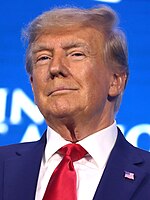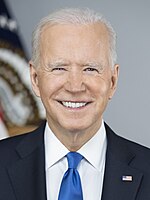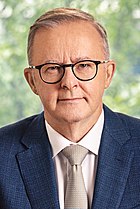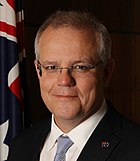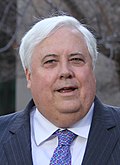User:GlowstoneUnknown/sandbox
British Empire 2.0
[edit]
| |||||||||||||||||||||||||||||||||||||
538 members of the Electoral College 270 electoral votes needed to win | |||||||||||||||||||||||||||||||||||||
|---|---|---|---|---|---|---|---|---|---|---|---|---|---|---|---|---|---|---|---|---|---|---|---|---|---|---|---|---|---|---|---|---|---|---|---|---|---|
| Opinion polls | |||||||||||||||||||||||||||||||||||||
| Turnout | 87.9% ( | ||||||||||||||||||||||||||||||||||||
| |||||||||||||||||||||||||||||||||||||
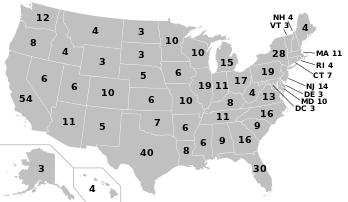 Presidential election results map. Grey indicates states won by Windsor/Windsor, blue denotes states won by Harris/Walz and red denotes those won by Trump/Pence. Numbers indicate electoral votes cast by each state and the District of Columbia. | |||||||||||||||||||||||||||||||||||||
| |||||||||||||||||||||||||||||||||||||
The 2024 United States presidential election was the last election held in the United States before its dissolution and later absorption into the Second British Empire (colloquially referred to as "The British Empire 2.0" or "The British Empire 2 - Electric Boogaloo". After a post from the official Twitter account of King Charles III of the United Kingdom announcing his candidacy for the election as a write-in candidate for the presidency, 56.33 million registered voters, purportedly upset by both the alleged rigging of the 2024 Democratic Party presidential primaries, leading to voters being unable to affect the party's choice of presidential nominee, alongside their dissatisfaction with the first Trump administration, decided to write in the monarch's name as a protest vote.
After the results were published on election night, the candidates from both major parties denied the results while Charles released a statement thanking the American people for voting him in. He pledged to "do what is right for America, however that must happen" and that he "shan't interfere with the democratic process".
Shortly after being sworn in as President in January, he announced the dissolution of both the House of Representatives and Senate, as well as the House of Commons, and the legislatures of all Commonwealth realms that recognise him as their monarch, and a return to absolute monarchist rule, formally establishing the Second British Empire.
Testing
[edit]
| |||||||||||||||||
538 members of the Electoral College 270 electoral votes needed to win | |||||||||||||||||
|---|---|---|---|---|---|---|---|---|---|---|---|---|---|---|---|---|---|
| Opinion polls | |||||||||||||||||
| |||||||||||||||||
 2024 electoral map, based on the results of the 2020 census | |||||||||||||||||
| |||||||||||||||||
| Party or alliance | Proportional | FPTP | Aosta Valley | |||||||||
|---|---|---|---|---|---|---|---|---|---|---|---|---|
| Votes | % | Seats | Votes | % | Seats | Votes | % | Seats | ||||
| Centre-right | Brothers of Italy | 7,302,517 | 100.00 | 69 | 1 | 100.00 | 69 | 12 | 100.00 | 0 | ||
| Total | 7,302,517 | 100.00 | 69 | 1 | 100.00 | 69 | 12 | 100.00 | 0 | |||
total voters: 7,868,079
total votes: 6,396,812
| ||||||||||||||||||||||||||||||||||||||||||||||||||||||||||||||||||||||||||||||||||||||
| ||||||||||||||||||||||||||||||||||||||||||||||||||||||||||||||||||||||||||||||||||||||
| Party | Votes | % | |
|---|---|---|---|
| CDU | 331,067 | 42.58 | |
| SPD | 265,516 | 34.15 | |
| GRU | 74,472 | 9.58 | |
| LEF | 50,132 | 6.45 | |
| FDP | 36,953 | 4.75 | |
| DVU | 6,354 | 0.82 | |
| OTH | 13,037 | 1.68 | |
| Total | 777,531 | 100.00 | |
| Party | Votes | % | |
|---|---|---|---|
| SPD | 580,422 | 54.14 | |
| CDU | 200,700 | 18.72 | |
| PDS | 200,628 | 18.72 | |
| DVU | 0 | 0.00 | |
| GRU | 31,033 | 2.89 | |
| FDP | 23,541 | 2.20 | |
| OTH | 35,685 | 3.33 | |
| Total | 1,072,009 | 100.00 | |
Austria 2024
[edit]
| |||||||||||||||||||||||||||||||||||||||||||||||||||||||||||||||||||||||||||||||||||||
All 183 seats in the National Council 92 seats needed for a majority | |||||||||||||||||||||||||||||||||||||||||||||||||||||||||||||||||||||||||||||||||||||
|---|---|---|---|---|---|---|---|---|---|---|---|---|---|---|---|---|---|---|---|---|---|---|---|---|---|---|---|---|---|---|---|---|---|---|---|---|---|---|---|---|---|---|---|---|---|---|---|---|---|---|---|---|---|---|---|---|---|---|---|---|---|---|---|---|---|---|---|---|---|---|---|---|---|---|---|---|---|---|---|---|---|---|---|---|---|
| Opinion polls | |||||||||||||||||||||||||||||||||||||||||||||||||||||||||||||||||||||||||||||||||||||
| Turnout | 81.3% ( | ||||||||||||||||||||||||||||||||||||||||||||||||||||||||||||||||||||||||||||||||||||
| |||||||||||||||||||||||||||||||||||||||||||||||||||||||||||||||||||||||||||||||||||||
| |||||||||||||||||||||||||||||||||||||||||||||||||||||||||||||||||||||||||||||||||||||
 | ||||||
|---|---|---|---|---|---|---|
| Party | Votes | % | +/– | Seats | +/– | |
| Freedom Party of Austria | 1,669,568 | 26.14 | 50 | |||
| Social Democratic Party of Austria | 1,464,870 | 22.94 | 44 | |||
| Austrian People's Party | 1,266,569 | 19.83 | 38 | |||
| The Greens – The Green Alternative | 652,475 | 10.22 | 19 | |||
| NEOS | 646,078 | 10.12 | 19 | |||
| BIER | 441,380 | 6.91 | 13 | |||
| KPÖ Plus | 236,043 | 3.70 | 0 | |||
| Others | 10,025 | 0.16 | – | – | ||
| Total | 6,387,008 | 100.00 | – | 183 | – | |
| Valid votes | 6,387,008 | 99.85 | ||||
| Invalid/blank votes | 9,804 | 0.15 | ||||
| Total votes | 6,396,812 | 100.00 | ||||
| Registered voters/turnout | 7,868,079 | 81.30 | ||||
Aftermath
[edit]The incumbent ÖVP-Greens government lost its majority, and a massive upset occurred with the Freedom Party of Austria being the party with the largest share of seats in the National Council. An unprecedented turn of events saw the formerly[a] satirical Beer Party gain a shocking 13 seats in the Council, leading to speculation as to whether or not they may be part of the cabinet to provide a centre-left majority.
Following Beer Party leader's Dominik Wlazny's most recent bid for President being far more serious than satirical, as was his party's first run for the National Council in the 2019 election, his party's platform had become one of civil libertarianism, drug liberalisation, and social liberalism, placing it on the centre to centre-left of the political spectrum for the 2024 election.
SPÖ leader Andreas Babler ruled out both a coalition with Kickl's FPÖ and a potential confidence and supply agreement, stating, "Kickl is a man who has no respect for rule of law and European values, I refuse to support him for the role of Chancellor." Shortly after, Greens leader Werner Kogler echoed Babler's sentiment, saying, "I don't believe there is any compromise that can be made with Kickl to allow me to support him as the leader of our country, his anti-environmentalist stances among many other issues disqualifies him from co-operating with the Greens.
President Alexander Van der Bellen appointed Herbert Kickl as the formateur, surprising the populace who'd assumed his overt criticism of Kickl and the FPÖ in the past would have stopped him from doing so.
Government formation
[edit]Kickl began by approaching the ÖVP, suggesting a repeat of the coalition following the 2017 election, but with the junior and senior partner positions reversed. Nehammer was hesitant to draw up any conclusive coalition agreements, claiming that he doesn't want to be part of a minority government, suggesting to Kickl to approach NEOS leader Beate Meinl-Reisinger about the possibility of forming a majority in the National Council.
Meinl-Resinger was brought into coalition talks the following week, and negotiations began between the 3 parties. Meinl-Reisinger strongly advocated for strengthening Austria's ties to the EU, while Kickl was firmly against it, sticking to his campaign promise of Austria withdrawing from the Eurozone. Nehammer tried to find an even compromise that all three parties could agree upon, but failed, with NEOS leaving the coalition talks only 2 weeks after they began. Nehammer subsequently broke off negotiations as well, his desire to have a majority in the National Council being the stated reason.
Kickl informed Van der Bellen that he was unable to form government, and recommended Nehammer for the position in his place. This was frowned upon as Babler of the SPÖ had more seats than Nehammer's ÖVP, leading to speculation that Kickl's recommendation was out of spite for Babler, due to the remarks he made about Kickl after the election.
Van der Bellen opted to appoint Babler as the next formateur, against the recommendation of Kickl.
Coalition talks re-opened with the SPÖ approaching the Greens and NEOS, to discuss a potential centre-left minority government with support from the Beer Party. NEOS leader Beate Meinl-Reisinger was hesitant to ally solely with left-wing parties, instead suggesting a grand coalition with SPÖ, NEOS, and the ÖVP.
Discussion began with the three parties despite Meinl-Reisinger's concerns, and preliminary agreements were drawn up. However, Meinl-Reisinger was still reluctant to form a minority cabinet, especially with only left-wing parties, so in a controversial move, Babler added Wlazny to the negotiations, discussing a majority cabinet, alleviating Meinl-Reisinger's concerns about a minority government, whilst providing another party closer to the centre to the discussions.
The second round of negotiations were a success, with a centre-left majority coalition being formed. Babler presented his government to President Van der Bellen and was sworn in as Chancellor, with Meinl-Reisinger being his pick for Vice-Chancellor.
2022 Australian federal election
[edit]
| ||||||||||||||||||||||||||||||||||||||||||||||||||||||||||||||||||||||||||||||||||||||||||||||||||||||||||||||||||||||||||||||||||
All 250 seats in the House of Representatives | ||||||||||||||||||||||||||||||||||||||||||||||||||||||||||||||||||||||||||||||||||||||||||||||||||||||||||||||||||||||||||||||||||
|---|---|---|---|---|---|---|---|---|---|---|---|---|---|---|---|---|---|---|---|---|---|---|---|---|---|---|---|---|---|---|---|---|---|---|---|---|---|---|---|---|---|---|---|---|---|---|---|---|---|---|---|---|---|---|---|---|---|---|---|---|---|---|---|---|---|---|---|---|---|---|---|---|---|---|---|---|---|---|---|---|---|---|---|---|---|---|---|---|---|---|---|---|---|---|---|---|---|---|---|---|---|---|---|---|---|---|---|---|---|---|---|---|---|---|---|---|---|---|---|---|---|---|---|---|---|---|---|---|---|---|
| Opinion polls | ||||||||||||||||||||||||||||||||||||||||||||||||||||||||||||||||||||||||||||||||||||||||||||||||||||||||||||||||||||||||||||||||||
| Registered | 17,228,900 | |||||||||||||||||||||||||||||||||||||||||||||||||||||||||||||||||||||||||||||||||||||||||||||||||||||||||||||||||||||||||||||||||
| Turnout | 89.82% ( | |||||||||||||||||||||||||||||||||||||||||||||||||||||||||||||||||||||||||||||||||||||||||||||||||||||||||||||||||||||||||||||||||
| ||||||||||||||||||||||||||||||||||||||||||||||||||||||||||||||||||||||||||||||||||||||||||||||||||||||||||||||||||||||||||||||||||
 | ||||||||||||||||||||||||||||||||||||||||||||||||||||||||||||||||||||||||||||||||||||||||||||||||||||||||||||||||||||||||||||||||||
| ||||||||||||||||||||||||||||||||||||||||||||||||||||||||||||||||||||||||||||||||||||||||||||||||||||||||||||||||||||||||||||||||||
The 2022 Australian federal election was held on Saturday 21 May 2022 to elect members of the 47th Parliament of Australia. The incumbent Prime Minister Bill Shorten stated he was not seeking another term as Prime Minister and had stepped down as Labor leader 3 months before the election due to personal reasons, however he agreed to remain Prime Minister in the interim. Labor Left leader Anthony Albanese was quickly elected leader of the Labor Party, and sought to win a third consecutive term for his party and second consecutive term for the government coalition.
Opposition leader Scott Morrison of the Liberal Party wished to defeat the Labor Party and secure the first Liberal government with support from their historical allies, the Queensland Conservatives, Nationals, and perhaps minor parties such as the Country Party and the United Australia Party.
The election took place under party-list proportional representation using the D'Hondt Method with a 4% national threshold and a 4% threshold in each of the 6 States and 2 self-governing Territories. 99 seats are won from the national total of each party's votes, while the remaining 151 are won in each state or territory, 47 in New South Wales, 38 in Victoria, 30 in Queensland, 16 in Western Australia, 10 in South Australia, 5 in Tasmania, 3 in the Australian Capital Territory, and 2 in the Northern Territory.
The Incumbent Labor-Greens coalition government maintained its majority, with Labor retaining all 99 of its seats and the Greens gaining 6.
The voter turnout of 89.82% in this election was the lowest in modern history, falling below 90% for the first time since 1922, prior to the introduction of Compulsory voting in Australia.
Results
[edit] | ||||||
|---|---|---|---|---|---|---|
| Party | Votes | % | +/– | Seats | +/– | |
| Labor | 4,776,030 | 34.40 | 99 | |||
| Liberal | 3,502,713 | 25.23 | 74 | |||
| Greens | 1,795,985 | 12.94 | 34 | |||
| Queensland Conservatives | 1,172,515 | 8.45 | 23 | |||
| One Nation Party | 727,464 | 5.24 | 9 | |||
| United Australia Party | 604,536 | 4.35 | 6 | |||
| National | 528,442 | 3.81 | 5 | |||
| Country | 29,664 | 0.21 | 1 | |||
| Others | 745,524 | 5.37 | – | – | ||
| Total | 13,882,873 | 100.00 | – | 251 | – | |
| Valid votes | 13,882,873 | 89.79 | ||||
| Invalid/blank votes | 1,579,467 | 10.21 | ||||
| Total votes | 15,462,340 | 100.00 | ||||
| Registered voters/turnout | 17,213,433 | 89.83 | ||||
Aftermath
[edit]Immediately following the election, the incumbent Labor/Greens coalition agreement was renegotiated between Bandt and Albanese, with the Greens gaining the Ministry for Agriculture from Labor. Psephologist Antony Green called the election for the current coalition government while 60% of the votes were counted[1], and while opposition leader Morrison was initially optimistic that his party could still command a right-leaning majority, he eventually conceded and stepped down as leader of the Liberal Party, with Josh Frydenberg being elected as Liberal leader shortly after.
In Queensland, David Crisafulli stepped down as leader of the Queensland Conservatives due to his party's third consecutive election without a role in government, allegedly leading to uproar within the party and amongst the right-wing populace of the state about them once again having no sway in parliament. Conservative veteran Peter Dutton replaced him as party leader, marking a sharp rightward shift for the QCP, with Dutton's politics being described as "nationalist"[2] and "right-wing populist"[3] by members of the federal government parties, and even by some anonymous moderate sources within his own party.
2019 Australian federal election (coming soon)
[edit]2019
[edit]National
[edit]| Party | Votes | % | Seats | |
|---|---|---|---|---|
| Liberal Party of Australia | 3,989,404 | 27.54 | 33 | |
| National Party of Australia | 642,233 | 4.43 | 5 | |
| Australian Labor Party | 4,752,160 | 32.80 | 39 | |
| Country Liberal Party | 38,837 | 0.27 | 0 | |
| Conservative | 1,236,401 | 8.53 | 10 | |
| One Nation | 438,587 | 3.03 | 0 | |
| United Australia Party | 488,817 | 3.37 | 0 | |
| Australian Greens | 1,482,923 | 10.24 | 12 | |
| Others | 1,418,658 | 9.79 | – | |
| Total | 14,488,020 | 100.00 | 99 | |
NSW
[edit]| Party | Votes | % | Seats | |
|---|---|---|---|---|
| Liberal Party of Australia | 1,461,560 | 35.59 | 18 | |
| National Party of Australia | 468,866 | 11.42 | 5 | |
| Australian Labor Party | 1,568,223 | 38.19 | 19 | |
| One Nation | 59,464 | 1.45 | 0 | |
| United Australia Party | 153,477 | 3.74 | 0 | |
| Australian Greens | 395,238 | 9.62 | 5 | |
| Total | 4,106,828 | 100.00 | 47 | |
VIC
[edit]| Party | Votes | % | Seats | |
|---|---|---|---|---|
| Liberal | 1,288,805 | 46.24 | 16 | |
| National | 136,737 | 4.91 | 0 | |
| Labor | 1,361,913 | 48.86 | 17 | |
| One Nation | 0 | |||
| United Australia | 0 | |||
| Greens | 5 | |||
| Total | 2,787,455 | 100.00 | 38 | |
QLD
[edit]| Party | Seats | |
|---|---|---|
| Conservative | 15 | |
| Labor | 9 | |
| One Nation | 3 | |
| United Australia | 0 | |
| Greens | 3 | |
| Total | 30 | |
WA
[edit]| Party | Seats | |
|---|---|---|
| Liberal | 8 | |
| National | 0 | |
| Labor | 5 | |
| One Nation | 1 | |
| United Australia | 0 | |
| Greens | 2 | |
| Total | 16 | |
SA
[edit]| Party | Seats | |
|---|---|---|
| Liberal | 5 | |
| National | 0 | |
| Labor | 4 | |
| One Nation | 0 | |
| United Australia | 0 | |
| Greens | 1 | |
| Total | 10 | |
TAS
[edit]| Party | Seats | |
|---|---|---|
| Liberal | 2 | |
| Labor | 3 | |
| One Nation | 0 | |
| United Australia | 0 | |
| Greens | 0 | |
| Total | 5 | |
NT
[edit]| Party | Seats | |
|---|---|---|
| Country | 1 | |
| Labor | 1 | |
| One Nation | 0 | |
| United Australia | 0 | |
| Greens | 0 | |
| Total | 2 | |
ACT
[edit]| Party | Seats | |
|---|---|---|
| Liberal | 1 | |
| Labor | 2 | |
| One Nation | 0 | |
| United Australia | 0 | |
| Greens | 0 | |
| Total | 3 | |
Anglish London
[edit]2024 Motunui general election
[edit]
| ||||||||||||||||||||||||||||||||||||||||||||||||||||||||||||||||||||||||||||||||||||||||||||||||||||||||||||||||||||||||||||||||||
All 89 seats in the Runanga Ture 45 seats needed for a majority | ||||||||||||||||||||||||||||||||||||||||||||||||||||||||||||||||||||||||||||||||||||||||||||||||||||||||||||||||||||||||||||||||||
|---|---|---|---|---|---|---|---|---|---|---|---|---|---|---|---|---|---|---|---|---|---|---|---|---|---|---|---|---|---|---|---|---|---|---|---|---|---|---|---|---|---|---|---|---|---|---|---|---|---|---|---|---|---|---|---|---|---|---|---|---|---|---|---|---|---|---|---|---|---|---|---|---|---|---|---|---|---|---|---|---|---|---|---|---|---|---|---|---|---|---|---|---|---|---|---|---|---|---|---|---|---|---|---|---|---|---|---|---|---|---|---|---|---|---|---|---|---|---|---|---|---|---|---|---|---|---|---|---|---|---|
| Registered | 78,549 | |||||||||||||||||||||||||||||||||||||||||||||||||||||||||||||||||||||||||||||||||||||||||||||||||||||||||||||||||||||||||||||||||
| Turnout | 92.53pp | |||||||||||||||||||||||||||||||||||||||||||||||||||||||||||||||||||||||||||||||||||||||||||||||||||||||||||||||||||||||||||||||||
| ||||||||||||||||||||||||||||||||||||||||||||||||||||||||||||||||||||||||||||||||||||||||||||||||||||||||||||||||||||||||||||||||||
| ||||||||||||||||||||||||||||||||||||||||||||||||||||||||||||||||||||||||||||||||||||||||||||||||||||||||||||||||||||||||||||||||||
The 2024 Motunui general election was held on 15 October 2024 after Timuaki Tama Ngata terminated the coalition agreement with the Farmers' Union (RKoM) following the scandal[1] surrounding party leader Anaru Henare's arrest for drug trafficking.[2] The election saw the worst ever result for RKoM, dipping below the 4% electoral threshold and losing all 20 of their seats. Newcomer Hone Ropata of the Community Party (RH) garnered 8.21% of the vote, entitling his party to 8 seats while senior coalition partner the Conservative Party (Kaitiaki) lost 14 seats. The Monarchist Party gained votes from the collapsing government coalition, doubling their seats from 7 to 14, and The Pākehā Party rose above the electoral threshold again after losing representation in 2021, the Green Party (Kākāriki) had modest gains of 2 seats and the Workers-Left Party (Mahi-Maui) Rose from third place to first, making them the clear winner of the election.
Aftermath
[edit]Following the announcement of the results, Ngata announced his resignation and stepped down as Timuaki. Subsequently, Rawiri Waititi of the Workers-Left Party started government formation negotiations with the other party leaders. Ngata refused the invitation from Waititi citing his opposition to forming a grand coalition and that he wasn't willing to provide external confidence and supply.
Waititi first met with Court on 20 October, after which Court announced his party would no longer take part in negotiations, claiming that the two parties had "different views on where this nation is headed". The same day, Ngā Wai Hono i te Pō attended a meeting with Waititi and also ruled out a coalition with Mahi-Maui, reasoning that Waititi's commitment to republicanism and his economic plan for the country were incompatible with her policies. However, she didn't rule out a potential confidence and supply agreement should negotiations with other parties fall through and the government be thrust into minority.
On 21 October, Waititi met with Ihimaera, who expressed concerns about economics and sustainable energy.
On 22 October, Waititi met with Ropata, who claimed his priorities were for strengthening employment protection for LGBT people, lowering the cost of living for citizens in the tax-free bracket, and improving government transparency.
On 23 October, the first meeting between the three party leaders (Waititi, Ihimaera, and Ropata) was held, where the three party leaders intended to create a "common policy agreement" in preparation for forming a majority coalition government.
On 30 October, the common policy agreement was finalised and the coalition agreement was signed, with Waititi being sworn in as Timuaki, Ihimaera as Timuaki Tuarua, and Ropata as Minita mo nga Take Tawahi (Minister of Foreign Affairs).
In the coalition agreement signed by the 3 parties, Mahi-Maui got 6 ministries, Kākāriki got 4, and RH got 2.
| Party | Votes | % | +/– | Seats | +/– | |
|---|---|---|---|---|---|---|
| Workers-Left Party | 19,464 | 27.64 | 26 | |||
| Conservative Party | 16,879 | 23.97 | 22 | |||
| Monarchist Party | 11,041 | 15.68 | 15 | |||
| Green Party of Motunui | 10,605 | 15.06 | 14 | |||
| The Community Party | 5,781 | 8.21 | New | 7 | New | |
| The Pākehā Party | 3,922 | 5.57 | 5 | |||
| Farmers' Union of Motunui | 2,451 | 3.48 | 0 | |||
| Others | 276 | 0.39 | – | – | ||
| Total | 70,419 | 100.00 | – | 89 | – | |
| Valid votes | 70,419 | 96.89 | ||||
| Invalid/blank votes | 2,263 | 3.11 | ||||
| Total votes | 72,682 | 100.00 | ||||
| Registered voters/turnout | 78,549 | 92.53 | ||||
Workers-Left Party Rōpū Mahi-Maui | |
|---|---|
| Abbreviation | RM-M |
| Kaihautū | Rawiri Waititi |
| Kaihautū Tuarua | Peeni Henare |
| Founded | 1967 March 5 |
| Merger of | Rōpū Mana Motuhake Rōpū Manapori |
| Youth wing | Kaimahi Rangatahi |
| LGBT wing | Kaimahi Takatāpui |
| Ideology | Social democracy[1] Progressivism[2] |
| Political position | Centre-left to left-wing[3] |
| International affiliation | Socialist International |
| Colours | Red |
| Slogan | E nga kaimahi o te ao, whakakotahi! (Workers of the world, unite!) |
| Māngai in the Runanga Ture | 26 / 89
|
| Website | |
| ropu-mahi-maui.mi | |
Conservative Party Rōpū Kaitiaki | |
|---|---|
| Rangatira | Tama Ngata |
| Rangatira Tuarua | Kiri Waititi |
| Founded | 1943 September 25 |
| Youth wing | Te Hunga Rangatahi Kaitiaki |
| Ideology | Conservatism (Motunui) Liberal conservatism[2] Historical: Paternalistic conservatism |
| Political position | Centre-right to right-wing[3] Historical: Centre to centre-right |
| Regional affiliation | Asia Pacific Democracy Union |
| International affiliation | International Democracy Union |
| Colours | Blueberry |
| Slogan | Ma nga Kaitiaki koe e tiaki (The Conservatives will take care of you) |
| Māngai in the Runanga Ture | 22 / 89
|
| Website | |
| ropu-kaitiaki.mi | |
Monarchist Party Rōpū Rangatiratanga | |
|---|---|
| Rangatira | Ngā Wai Hono i te Pō |
| Founded | 1983 December 12 |
| Youth wing | Rangatahi mo te Rangatiratanga |
| Ideology | Constitutional monarchism[1] Motunui nationalism Civic nationalism[2] Economic liberalism |
| Political position | Centre to centre-right[3] |
| Colours | Byzantine Purple |
| Māngai in the Runanga Ture | 14 / 89
|
| Website | |
| rangatiratanga.gov.mi | |
Green Party of Motunui Te Rōpū Kākāriki o Motunui | |
|---|---|
| Abbreviation | TRK RK |
| Kaihautū | Kahurangi Ihimaera |
| Kaihautū Tuarua | Marama Paratene |
| Founded | 1992 November 23 |
| Youth wing | Te Kaupapa Rangatahi Kākāriki |
| LGBT wing | Ngā Kākāriki Takatāpui |
| Ideology | Green politics[1] Progressivism[2] Faction: Eco-socialism |
| Political position | Left-wing[3] |
| International affiliation | Global Greens |
| Colours | Lime |
| Māngai in the Runanga Ture | 14 / 89
|
| Website | |
| kaakaariki-o-motunui.mi | |
The Community Party Te Rōpū Hapori | |
|---|---|
| Abbreviation | RH |
| Kaihautū | Hone Ropata |
| Kaihautū Tuarua | Mika Haka |
| Founded | 2023 January 2 |
| Ideology | Populism[1] Social liberalism[2] |
| Political position | Centre to centre-left[3] |
| Colours | Topaz |
| Māngai in the Runanga Ture | 8 / 89
|
| Website | |
| roopu-hapori.mi | |
Pākehā Party Pāti Pākehā | |
|---|---|
| Abbreviation | PP |
| Kaihautū | Haimona Court |
| Kaihautū Tuarua | Rawiri Seymour |
| Founded | 2004 July 21 |
| Split from | Left-Workers Party Conservative Party |
| Ideology | Pākehā interests Populism[1] Right-libertarianism Social conservatism[2] Historical: Social liberalism Christian democracy[3] |
| Political position | Right-wing[4] Historical: Big tent[5] |
| Colours | Orange |
| Māngai in the Runanga Ture | 5 / 89
|
| Website | |
| paakehaa-party.mi | |
Farmers' Union of Motunui Rōpū Kaiahuwhenua o Motunui | |
|---|---|
| Abbreviation | RKoM |
| Rangatira | Anaru Henare |
| Rangatira Tuarua | Winitana Pita |
| Founded | 1927 July 21 |
| Youth wing | Nga Rangatahi Kaiahuwhenua o Motunui |
| Ideology | Agrarianism[1] Liberalism[2] Liberal conservatism[3] Populism |
| Political position | Centre-right[4] |
| Colours | Green |
| Māngai in the Runanga Ture | 0 / 89
|
| Website | |
| RKOM.mi | |




